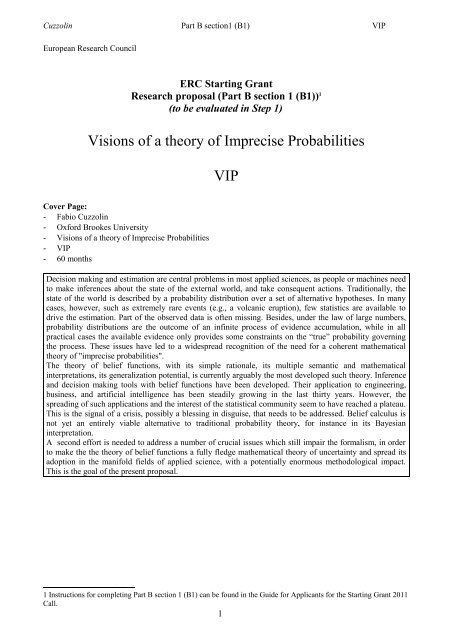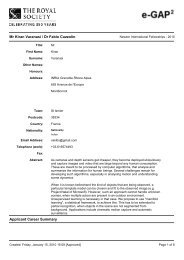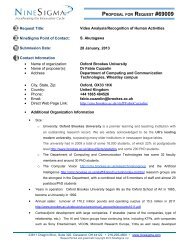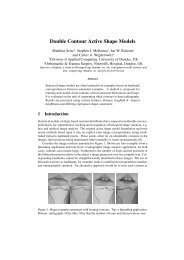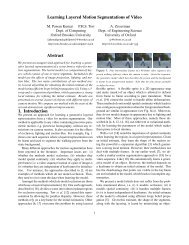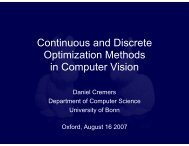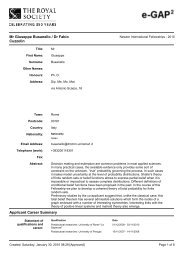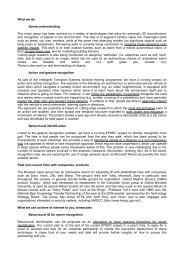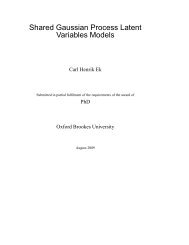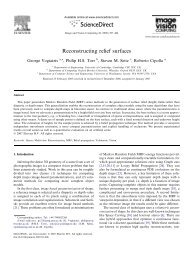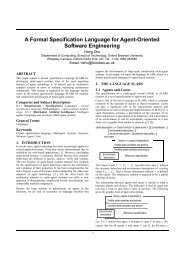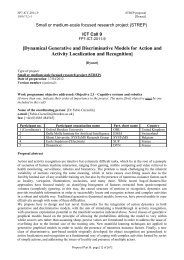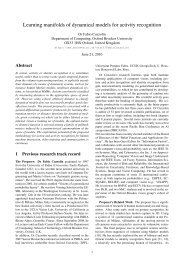Visions of a theory of Imprecise Probabilities VIP - Oxford Brookes ...
Visions of a theory of Imprecise Probabilities VIP - Oxford Brookes ...
Visions of a theory of Imprecise Probabilities VIP - Oxford Brookes ...
You also want an ePaper? Increase the reach of your titles
YUMPU automatically turns print PDFs into web optimized ePapers that Google loves.
Cuzzolin Part B section1 (B1) <strong>VIP</strong><br />
European Research Council<br />
ERC Starting Grant<br />
Research proposal (Part B section 1 (B1)) 1<br />
(to be evaluated in Step 1)<br />
<strong>Visions</strong> <strong>of</strong> a <strong>theory</strong> <strong>of</strong> <strong>Imprecise</strong> <strong>Probabilities</strong><br />
Cover Page:<br />
- Fabio Cuzzolin<br />
- <strong>Oxford</strong> <strong>Brookes</strong> University<br />
- <strong>Visions</strong> <strong>of</strong> a <strong>theory</strong> <strong>of</strong> <strong>Imprecise</strong> <strong>Probabilities</strong><br />
- <strong>VIP</strong><br />
- 60 months<br />
<strong>VIP</strong><br />
Decision making and estimation are central problems in most applied sciences, as people or machines need<br />
to make inferences about the state <strong>of</strong> the external world, and take consequent actions. Traditionally, the<br />
state <strong>of</strong> the world is described by a probability distribution over a set <strong>of</strong> alternative hypotheses. In many<br />
cases, however, such as extremely rare events (e.g., a volcanic eruption), few statistics are available to<br />
drive the estimation. Part <strong>of</strong> the observed data is <strong>of</strong>ten missing. Besides, under the law <strong>of</strong> large numbers,<br />
probability distributions are the outcome <strong>of</strong> an infinite process <strong>of</strong> evidence accumulation, while in all<br />
practical cases the available evidence only provides some constraints on the “true” probability governing<br />
the process. These issues have led to a widespread recognition <strong>of</strong> the need for a coherent mathematical<br />
<strong>theory</strong> <strong>of</strong> "imprecise probabilities".<br />
The <strong>theory</strong> <strong>of</strong> belief functions, with its simple rationale, its multiple semantic and mathematical<br />
interpretations, its generalization potential, is currently arguably the most developed such <strong>theory</strong>. Inference<br />
and decision making tools with belief functions have been developed. Their application to engineering,<br />
business, and artificial intelligence has been steadily growing in the last thirty years. However, the<br />
spreading <strong>of</strong> such applications and the interest <strong>of</strong> the statistical community seem to have reached a plateau.<br />
This is the signal <strong>of</strong> a crisis, possibly a blessing in disguise, that needs to be addressed. Belief calculus is<br />
not yet an entirely viable alternative to traditional probability <strong>theory</strong>, for instance in its Bayesian<br />
interpretation.<br />
A second effort is needed to address a number <strong>of</strong> crucial issues which still impair the formalism, in order<br />
to make the the <strong>theory</strong> <strong>of</strong> belief functions a fully fledge mathematical <strong>theory</strong> <strong>of</strong> uncertainty and spread its<br />
adoption in the manifold fields <strong>of</strong> applied science, with a potentially enormous methodological impact.<br />
This is the goal <strong>of</strong> the present proposal.<br />
1 Instructions for completing Part B section 1 (B1) can be found in the Guide for Applicants for the Starting Grant 2011<br />
Call.<br />
1
Cuzzolin Part B section1 (B1) <strong>VIP</strong><br />
Section 1: The Principal Investigator (see Guide for Applicants for the Starting Grant 2011 Call)<br />
1(a) Scientific Leadership Potential 2 (max 1 page)<br />
Dr Fabio Cuzzolin has a broad international experience, as he worked as a researcher in six world-class<br />
institutions <strong>of</strong> four different countries on both sides <strong>of</strong> the Atlantic. He graduated in 1997 from the<br />
University <strong>of</strong> Padua (Universitas Studii Paduani, founded 1222, is the seventh most ancient university in the<br />
world) with a laurea magna cum laude in Computer Engineering. He received a Ph.D. degree from the same<br />
institution in 2001, for a thesis entitled “<strong>Visions</strong> <strong>of</strong> a generalized probability <strong>theory</strong>". During his Ph.D. he<br />
was Visiting Scholar in the ESSRL laboratory <strong>of</strong> the Washington University in St. Louis (12th in the US<br />
universities ranking, 2009). He was later appointed fixed-term Assistant Pr<strong>of</strong>essor by Politecnico di Milano,<br />
Milan, Italy, consistently recognized as the top university in the country. He later moved as a Postdoctoral<br />
Fellow to the UCLA Vision Lab, University <strong>of</strong> California at Los Angeles (24th in the US ranking). In 2006<br />
he was awarded a Marie Curie Fellowship in partnership with INRIA Rhone-Alpes, France. Since September<br />
2008 he has been a Lecturer and Early Career Fellow in the Department <strong>of</strong> Computing <strong>of</strong> <strong>Oxford</strong> <strong>Brookes</strong><br />
University, <strong>Oxford</strong>, U.K. Dr Cuzzolin is an integral part <strong>of</strong> the <strong>Oxford</strong> University - <strong>Oxford</strong> <strong>Brookes</strong> joint<br />
research group led by Pr<strong>of</strong>essors Phil Torr and Andrew Zisserman. The group is well known as one <strong>of</strong><br />
world's best and has won an incredible number <strong>of</strong> awards in the recent past, last ones the best paper awards<br />
at the British Machine Vision Conference 2010 and the European Conference on Computer Vision 2010.<br />
Dr Cuzzolin classified second in the 2007 Senior Researcher (CR1) national recruitment at INRIA, and had<br />
interviews with/<strong>of</strong>fer from <strong>Oxford</strong> University, EPFL, Universitat Pompeu Fabra, UCSD, GeorgiaTech, U.<br />
Houston, Honeywell Labs, Riya.<br />
Given his career stage and his early achievements, Dr Cuzzolin can be considered a “consolidator”.<br />
Dr Cuzzolin's research interests span imprecise (non-additive) probabilities, with a focus on belief<br />
functions, computer vision, and machine learning.<br />
He is a recognized prominent expert in the field <strong>of</strong> belief functions and finite uncertainty measures, and a<br />
member <strong>of</strong> the Board <strong>of</strong> Directors <strong>of</strong> the Belief Functions and Applications Society. He formulated a<br />
geometric approach to uncertainty measures in which various uncertainty measures can be represented as<br />
points <strong>of</strong> a Cartesian space and there analyzed. Within computer vision, his work focuses on human motion<br />
analysis and action recognition, while in machine learning it mainly concerns large scale manifold learning.<br />
Dr Fabio Cuzzolin is author at the present time <strong>of</strong> 52 peer-reviewed publications. He is first or single author<br />
<strong>of</strong> 44 such publications. Of these, thirty have been published in the last three years alone. He is single author<br />
<strong>of</strong> 2 book chapters, 8 journal papers, and 10 chapters in book series. One <strong>of</strong> his papers won the best paper<br />
award at the PRICAI'08 symposium. Four more articles (all <strong>of</strong> them single-author) are currently under<br />
review. Twelve additional journal papers are in the process <strong>of</strong> being submitted in the very near future.<br />
Dr Cuzzolin is working on a monograph collecting his work on the geometry <strong>of</strong> uncertainty measures.<br />
He collaborates as a reviewer with several journals in both computer vision and imprecise<br />
probabilities (such as the IEEE Trans. SMC – B and C, the IEEE Trans. on Fuzzy Systems, the Int. J.l on<br />
Approximate Reasoning, Computer Vision and Image Understanding, Information Sciences, the Journal <strong>of</strong><br />
Risk and Reliability, the Int. J. on Uncertainty, Fuzziness, and Knowledge-Based Systems, etc, see CV).<br />
He has been a guest editor for Information Fusion, has served in the Programme Committee <strong>of</strong> some 20<br />
international conferences, and serves as a reviewer in major vision conferences such as BMVC and ECCV.<br />
Dr Cuzzolin has an extensive teaching experience at university level in three different countries, first<br />
as a teaching assistant (T.A) in Padua and Milan, later as a T.A. at UCLA, and eventually as the Module<br />
Leader for a number <strong>of</strong> honours courses at <strong>Oxford</strong> <strong>Brookes</strong> University. He has been co-supervisor <strong>of</strong> two<br />
Ph.D. students in France and the UK, and supervised several Master's students' final year dissertations.<br />
Concerning grants and awards,Dr Cuzzolin has recently submitted two Royal Society's Newton<br />
International Fellowshipapplications as UK sponsor. He has just submitted his EPSRC First Grant, and has<br />
applied for a Project Grant on “The total probability theorem for finite random sets" with the Leverhulme<br />
Trust. He is now finalizing as the coordinator a Short Proposal for a Future and Emerging Technology (FET-<br />
Open)FP7 EU grant on “Large scale hybrid manifold learning", with INRIA, Pompeu Fabra and Technion as<br />
partners. At European level he is also organizing with IDSIA, Universiteit Gent, and the Milan company<br />
March Networks a STREP on “<strong>Imprecise</strong> Markov models for gesture recognition" which will be submitted<br />
to Call 7 in January 2011. Finally, he is setting up an EPSRC project at UK level on inference and decision<br />
making under uncertainty in partnership with U. Bristol, Manchester Metropolitan, and U. Belfast.<br />
2 By default "Starters" being those awarded their PhD from 2 up to 7 years prior to the Starting Grant call publication,<br />
and "Consolidators" being normally those awarded their PhD over 7 years and up to 12 years prior to the Starting Grant<br />
call publication.<br />
2
Cuzzolin Part B section1 (B1) <strong>VIP</strong><br />
1(b) Curriculum Vitae (max 2 pages)<br />
Personal information<br />
Nationality : Italian, Birthdate : October 5, 1971, Current residence : United Kingdom<br />
Education<br />
2001 Ph.D. Industrial Electronics and Computer Science, University <strong>of</strong> Padua (Italy) (date awarded:<br />
February 19, 2001)<br />
1997 M.S. Computer Engineering, University <strong>of</strong> Padua<br />
Pr<strong>of</strong>essional experience<br />
9/2008 – present Lecturer and Early Career Fellow<br />
Department <strong>of</strong> Computing, <strong>Oxford</strong> <strong>Brookes</strong> University<br />
9/2006 – 9/2008 Marie-Curie fellow<br />
INRIA - Insitut National de Recherche en Informatique et en Automatique, Grenoble, France<br />
10/2004 – 4/2006 Post-doctoral researcher<br />
UCLA Vision Lab, Computer Science Department, University <strong>of</strong> California at Los Angeles<br />
1/2003 – 12/2004 Fixed-term Assistant Pr<strong>of</strong>essor (Giovane Ricercatore)<br />
Department <strong>of</strong> Electronics and Information, Politecnico di Milano, Milan, Italy<br />
5/2001 – 5/2003 Post-doctoral researcher<br />
Autonomous Navigation and Computer Vision Lab, Dept. <strong>of</strong> Information Engineering., U. Padua<br />
6/2000 – 12/2000 Visiting student<br />
ESSRL Laboratory, Washington University in St. Louis<br />
3/1998 – 3/2001 Ph.D. Student - Research Assistant<br />
Autonomous Navigation and Computer Vision Lab, Dept. <strong>of</strong> Information Engineering., U. Padua<br />
Recent job <strong>of</strong>fers and interviews<br />
• Dr Cuzzolin classified second in the final ranking for the 2007 Senior Researcher (Chargèe de<br />
Recherche de Premiere Classe) recruitment at INRIA – Rennes (May 2007);<br />
• He was short-listed for a faculty position by Robert Gordon University, Aberdeen (June 2008);<br />
• He was <strong>of</strong>fered a four-year fellowship by: Pompeu Fabra, Barcelona - CILAB (May 2006);<br />
• He recently had interviews with/<strong>of</strong>fers from: <strong>Oxford</strong> University, Georgia Institute <strong>of</strong> Technology;<br />
University <strong>of</strong> California at San Diego; EPFL - IDIAP - Martigny, Switzerland; University <strong>of</strong> Houston;<br />
• He had interviews for senior researcher positions with/<strong>of</strong>fers from: Honeywell Labs - Minneapolis (June<br />
2006) Riya - Mountain View, CA (June 2006).<br />
Awards<br />
• Best Paper Award for the outstanding technical contribution: «Alternative formulations <strong>of</strong> the<br />
<strong>theory</strong> <strong>of</strong> evidence based on basic plausibility and commonality assignments», Pacific Rim<br />
International Conference on Artificial Intelligence, Hanoi, Vietnam, December 2008<br />
• Marie Curie fellowship, September 2006 - September 2008<br />
Membership <strong>of</strong> Boards <strong>of</strong> Societies<br />
• Member <strong>of</strong> the Board <strong>of</strong> Directors <strong>of</strong> the Belief Functions and Applications Society<br />
Membership <strong>of</strong> Editorial boards <strong>of</strong> international journals<br />
• Guest editor for Elsevier's Information Fusion Journal: CFP on "Competing Fusion Methods - Realworld<br />
Performances"<br />
Membership <strong>of</strong> Technical Program Committe <strong>of</strong> international conferences<br />
• ISIPTA 2009, ISIPTA 2011 –Int. Symposium on <strong>Imprecise</strong> <strong>Probabilities</strong> and Their Applications<br />
3
Cuzzolin Part B section1 (B1) <strong>VIP</strong><br />
• ECSQARU 2009, 2011 – European Conf. on Symbolic and Quantitative Approaches to Uncertainty<br />
• BELIEF 2010 - First International Workshop on the Theory <strong>of</strong> Belief Functions<br />
• IUM2010 - International Symposium on Integrated Uncertainty Management and Applications<br />
• FLAIRS'08 - FLAIRS'09 - FLAIRS'10 - FLAIRS'11 - Uncertain Reasoning track <strong>of</strong> the 21st, 22nd, 23rd,<br />
and 24th International Florida Artificial Intelligence Research Society Conferences<br />
• Session Chair for the 10th International Symposium on Artificial Intelligence and Mathematics (ISAIM<br />
2008), Fort Lauderdale, Florida, January 2-4 2008.<br />
• IMMERSCOM 2007 - 2nd International Conference on Immersive Telecommunications<br />
• VISAPP 2006, VISAPP 2007, VISAPP 2008, VISAPP 2009, VISAPP 2010, VISAPP 2011 -<br />
International Conference on Computer Vision Theory and Applications<br />
Reviewer for the following international journals on artificial intelligence, uncertainty <strong>theory</strong>, and vision:<br />
IEEE Trans. on Systems, Man, and Cybernetics - parts B and C, IEEE Trans. on Fuzzy Systems, IEEE Trans.<br />
on PAMI, Int. J. on Approximate Reasoning, Information Fusion, Computer Vision and Image<br />
Understanding, Int. J. on Uncertainty, Fuzziness, and Knowledge-Based Systems, Image and Vision<br />
Computing, Information Sciences, J. <strong>of</strong> Risk and Reliability, Annals <strong>of</strong> Operations Research.<br />
Also reviewer for major computer vision conferences such as ECCV and BMVC.<br />
Other collaborations<br />
• Member <strong>of</strong> the Society for <strong>Imprecise</strong> <strong>Probabilities</strong> and Their Applications;<br />
• Member <strong>of</strong> the IEEE Systems, Man, and Cybernetics Society<br />
Tutored Master's and PhD students<br />
• Mostafa Kamali Tabrizi, Ph.D. student - <strong>Oxford</strong> <strong>Brookes</strong> University, UK;<br />
• Massimiliano Pierobon (Politecnico di Milano), Laurent Simon, Thomas Coville, Dan Williams,<br />
Deepak Sharma (<strong>Oxford</strong> <strong>Brookes</strong> University).<br />
Funding ID - Research grant proposals as Principal Investigator<br />
• <strong>Oxford</strong> <strong>Brookes</strong> University - Central university funding: Uncertainty in Computer Vision, 12<br />
months, 3600 pounds, awarded;<br />
• The Royal Society - Newton International Fellowships: The total probability theorem for finite<br />
random sets or belief functions, 24 months, 98000 pounds, pending;<br />
• Engineering and Physical Sciences Research Council (EPSRC) - First Grant Scheme: Tensorial<br />
modeling <strong>of</strong> dynamical systems for gait and activity recognition, 2 years, 122000 pounds, pending;<br />
• Leverhulme Trust - Research Projects Grants: The total probability theorem for belief functions,<br />
3 years, 121781 pounds, pending;<br />
• European Union FP7 – FET-Open: Large scale hybrid manifold learning, 3 years, ~2 million<br />
euros (partners: INRIA, U. Pompeu Fabra, Technion), in preparation;<br />
• European Research Council - Starting Grant: <strong>Visions</strong> <strong>of</strong> a <strong>theory</strong> <strong>of</strong> <strong>Imprecise</strong> <strong>Probabilities</strong>, 5<br />
years, 1.45 million euros, in preparation;<br />
• European Union FP7 - Call 7 - STREP: <strong>Imprecise</strong> Markov chains for gesture recognition, 3 years,<br />
~1.4 million euros (partners: IDSIA, U. Gent, March Networks), in preparation;<br />
• Engineering and Physical Sciences Research Council (EPSRC): A network on uncertainty <strong>theory</strong><br />
(partners: U. Bristol, Manchester Metropolitan, U. Belfast), in preparation.<br />
Other research projects I partecipated in as a paid member <strong>of</strong> staff:<br />
• Politecnico di Milano - FIRB - VICOM, Virtual Immersive Communication, Italy Ministry <strong>of</strong><br />
University and Scientific Research, 2003-5;<br />
• INRIA Rhone-alpes - VISIONTRAIN, network <strong>of</strong> excellence in computer vision.<br />
4
Cuzzolin Part B section1 (B1) <strong>VIP</strong><br />
1(c) Early Achievement-Track-Record (max 2 pages)<br />
Publications as main author, most relevant to this research project (selected out <strong>of</strong> 52 peer reviewed papers),<br />
which are used for citation in the body <strong>of</strong> the proposal.<br />
Publications as main author in peer-reviewed international journals and conference proceedings<br />
[1] F. Cuzzolin, Geometry <strong>of</strong> relative plausibility and relative belief <strong>of</strong> singletons, Annals <strong>of</strong> Mathematics<br />
and Artificial Intelligence, pp. 1-33, July 26 2010<br />
[2] F. Cuzzolin, The geometry <strong>of</strong> consonant belief functions: simplicial complexes <strong>of</strong> necessity measures,<br />
Fuzzy Sets and Systems, 161(10), pp. 1459-1479, 16 May 2010<br />
[3] F. Cuzzolin, Credal semantics <strong>of</strong> Bayesian transformations in terms <strong>of</strong> probability intervals, IEEE<br />
Transaction on Systems, Man, and Cybernetics - part B, Vol. 40(2), pp. 421-432, April 2010<br />
[4] F. Cuzzolin, Three alternative combinatorial formulations <strong>of</strong> the <strong>theory</strong> <strong>of</strong> evidence, Special Issue <strong>of</strong><br />
PRICAI'08 Selected Papers, Intelligent Decision Analysis journal, 2010<br />
[5] F. Cuzzolin, A geometric approach to the <strong>theory</strong> <strong>of</strong> evidence, IEEE Transactions on Systems, Man,<br />
and Cybernetics part C, 38(4), pp. 522-534, July 2008<br />
[6] F. Cuzzolin, Two new Bayesian approximations <strong>of</strong> belief functions based on convex geometry, IEEE<br />
Transactions on Systems, Man, and Cybernetics part B, 37(4), pp. 993-1008, August 2007.<br />
[7] F. Cuzzolin, Algebraic structure <strong>of</strong> the families <strong>of</strong> compatible frames <strong>of</strong> discernment, Ann. Math. Artif.<br />
Intell. 45(1-2), pp. 241-274, 2005.<br />
[8] F. Cuzzolin, Geometry <strong>of</strong> Dempster's rule <strong>of</strong> combination, IEEE Transactions on Systems, Man, and<br />
Cybernetics part B, 34(2), pp. 961- 977, April 2004.<br />
[9] F. Cuzzolin, Geometric conditioning <strong>of</strong> belief functions, Proceedings <strong>of</strong> the First International Workshop<br />
on the Theory <strong>of</strong> Belief Functions (BELIEF 2010), Brest, April 2010<br />
[10] F. Cuzzolin, Consistent approximations <strong>of</strong> belief functions, Proceedings <strong>of</strong> the International Symposium<br />
on <strong>Imprecise</strong> <strong>Probabilities</strong> and Their Applications (ISIPTA'09), Durham, UK, July 14-18 2009;<br />
[11] F. Cuzzolin, Credal semantics <strong>of</strong> Bayesian approximations, Proc. <strong>of</strong> ISIPTA'09, Durham, July 2009;<br />
[12] F. Cuzzolin, Learning pullback metrics for linear models, European Conference on Computer Vision<br />
(ECCV'08), First workshop on Machine Learning for Vision-based Motion Analysis, Marseille, 2008<br />
[13] F. Cuzzolin, D. Mateus, D. Knossow, E. Boyer, R. Horaud, “Coherent Laplacian 3-D protrusion<br />
segmentation”, Proc. <strong>of</strong> CVPR'08 (Computer Vision and Pattern Recognition), pp.1 -8, Anchorage, 2008.<br />
[14] F. Cuzzolin, Boolean and matroidal independence in uncertainty <strong>theory</strong>, Proc. <strong>of</strong> the 10th<br />
International Symposium on Mathematics and Artificial Intelligence ISAIM'08, Fort Lauderdale,<br />
January 2-4 2008.<br />
[15] F. Cuzzolin, An interpretation <strong>of</strong> consistent belief functions in terms <strong>of</strong> simplicial complexes,<br />
Proceedings <strong>of</strong> ISAIM'08, Fort Lauderdale, Florida, January 2-4 2008.<br />
[16] F. Cuzzolin, Using Bilinear Models for View-invariant Action and Identity Recognition, Proc. <strong>of</strong><br />
CVPR'06, pp. 1701-1708, New York, June 18-22 2006.<br />
[17] F. Cuzzolin, The geometry <strong>of</strong> relative plausibilities, Proc <strong>of</strong> the 11th International Conference on<br />
Information Processing and Management <strong>of</strong> Uncertainty IPMU'06, Paris, July 2006.<br />
[18] F. Cuzzolin, On the properties <strong>of</strong> relative plausibilities, Proc. <strong>of</strong> the International Conference <strong>of</strong> the<br />
IEEE Systems, Man, and Cybernetics Society (SMC'05), vol.1, pp. 594-599, Hawaii, October 2005.<br />
[19] F. Cuzzolin, R. Frezza, Evidential modeling for pose estimation, Proc. <strong>of</strong> the 4th International<br />
Symposium on <strong>Imprecise</strong> <strong>Probabilities</strong> and Their Applications (ISIPTA'05), Pittsburgh, June 2005.<br />
[20] F. Cuzzolin, A. Sarti, S. Tubaro, Invariant action classification with volumetric data, International<br />
Workshop on Multimedia Signal Processing, pp. 395-398, Siena, Italy, 9/29-10/1 2004.<br />
[21] F. Cuzzolin, A. Sarti, S. Tubaro, Action modeling with volumetric data, Proc. <strong>of</strong> the 2004 International<br />
Conference on Image Processing (ICIP'04), vol. 2, pp. 881- 884, Singapore, October 24-27, 2004.<br />
[22] F. Cuzzolin, Simplicial complexes <strong>of</strong> finite fuzzy sets, Proc. <strong>of</strong> the International Conference on<br />
Information Processing and Management <strong>of</strong> Uncertainty (IPMU'04), pp. 1733-1740 Perugia, July 2004.<br />
[23] F. Cuzzolin, Geometry <strong>of</strong> upper probabilities, Proceedings <strong>of</strong> the 3rd International Symposium on<br />
<strong>Imprecise</strong> <strong>Probabilities</strong> and Their Applications (ISIPTA'03), Lugano, Switzerland, July 14-17, 2003.<br />
[24] F. Cuzzolin, R. Frezza, A. Bissacco, S. Soatto, Towards unsupervised detection <strong>of</strong> actions in clutter,<br />
Proc. <strong>of</strong> the 2002 Asilomar Conference on Signals, Systems, and Computers, vol.1, pp. 463-467, 2002.<br />
[25] F. Cuzzolin, Geometry <strong>of</strong> Dempster's rule, 2002 International Conference on Fuzzy Systems and<br />
Knowledge Discovery (FSKD'02), Special Session on Knowledge Representation under Vagueness and<br />
Uncertainty, Singapore, November 18-22, 2002.<br />
5
Cuzzolin Part B section1 (B1) <strong>VIP</strong><br />
[26] F. Cuzzolin, R. Frezza, Geometric analysis <strong>of</strong> belief space and conditional subspaces, Proc. <strong>of</strong> the 2nd<br />
Int. Symposium on <strong>Imprecise</strong> <strong>Probabilities</strong> and Their Applications (ISIPTA'01), Ithaca, June 2001.<br />
[27] F. Cuzzolin, R. Frezza, Lattice structure <strong>of</strong> the families <strong>of</strong> compatible frames <strong>of</strong> discernment, Proc. <strong>of</strong><br />
ISIPTA'01, Ithaca, NY, June 26-29, 2001.<br />
[28] F. Cuzzolin, R. Frezza, Integrating feature spaces for object tracking, Proc. <strong>of</strong> the International<br />
Symposium on the Mathematical Theory <strong>of</strong> Networks and Systems (MTNS2000), Perpignan, June 2000.<br />
[29] F. Cuzzolin, R. Frezza, An evidential reasoning framework for object tracking, Proc. <strong>of</strong> SPIE -<br />
Photonics East 99 - Telemanipulator and Telepresence Technologies VI, vol. 3840, pp. 13-24, 1999.<br />
Research monographs and chapters in collective volumes<br />
[30] F. Cuzzolin, <strong>Visions</strong> <strong>of</strong> a generalized probability <strong>theory</strong>, Ph.D. dissertation, Università degli Studi di<br />
Padova, Italy, March 2001.<br />
[31] F. Cuzzolin, Multilinear modeling for robust identity recognition from gait, in “Behavioral Biometrics<br />
for Human Identification: Intelligent Applications", L. Wang and X. Geng (Eds.), IGI Publishing, 2009<br />
[32] F. Cuzzolin, Manifold learning for multi-dimensional auto-regressive dynamical models, in “Machine<br />
Learning for Vision-based Motion Analysis", L. Wang, G. Zhao, L. Cheng, M. Pietikaaine (Eds.),<br />
Springer, 2010<br />
[33] F. Cuzzolin, Complexes <strong>of</strong> outer consonant approximations, in “Symbolic and Quantitative Approaches<br />
to Reasoning with Uncertainty" (ECSQARU'09), Lecture Notes in Computer Science, Vol. 5590/2009,<br />
pages 275-286, Springer Berlin / Heidelberg, 2009<br />
[34] F. Cuzzolin, The intersection probability and its properties, in “Symbolic and Quantitative Approaches<br />
to Reasoning with Uncertainty" (ECSQARU'09), Lecture Notes in Computer Science, Vol. 5590/2009,<br />
pages 287-298, Springer Berlin / Heidelberg, 2009<br />
[35] F. Cuzzolin, Alternative formulations <strong>of</strong> the <strong>theory</strong> <strong>of</strong> evidence based on basic plausibility and<br />
commonality assignments, in “PRICAI 2008: Trends in Artificial Intelligence", Lecture Notes in Computer<br />
Science, Vol. 5351/2008, pages 91-102, Springer Berlin / Heidelberg, 2009<br />
[36] F. Cuzzolin, Dual properties <strong>of</strong> the relative belief <strong>of</strong> singletons, in “PRICAI 2008: Trends in Artificial<br />
Intelligence", Lecture Notes in Computer Science, Vol. 5351/2008, pp. 78-90, Springer Berlin, 2009<br />
[37] F. Cuzzolin, On the credal structure <strong>of</strong> consistent probabilities, in Logics in Artificial Intelligence,<br />
Lecture Notes in Computer Science, Vol. 5293/2008, pp. 126-139, Springer Berlin / Heidelberg, 2008.<br />
[38] F. Cuzzolin, A lattice-theoretic interpretation <strong>of</strong> independence on frames, in «Interval / Probabilistic<br />
Uncertainty and Non-classical Logics», Advances in S<strong>of</strong>t Computing, Vol. 46, Huynh, V.-N.; Nakamori,<br />
Y.; Ono, H.; Lawry, J.; Kreinovich, V.; Nguyen, H.T. (Eds.), Springer-Verlag, Berlin, 2008.<br />
[39] F. Cuzzolin, Semantics <strong>of</strong> the relative belief <strong>of</strong> singletons, in «Interval / Probabilistic Uncertainty and<br />
Non-classical Logics», Advances in S<strong>of</strong>t Computing, Vol. 46, Springer-Verlag, Berlin, 2008.<br />
[40] F. Cuzzolin, D. Mateus, E. Boyer, R. Horaud, Robust spectral 3D-bodypart segmentation in time, in<br />
«Human Motion - Understanding, Modeling, Capture and Animation», LNCS, Vol. 4814/2007, pp. 196-211,<br />
Seidel, H.-P.; Wang, Y.; Rosenhahn, B.; Mori, G. (Eds.), Springer Berlin / Heidelberg, 2007.<br />
[41] F. Cuzzolin, On the orthogonal projection <strong>of</strong> a belief function, in «Symbolic and Quantitative<br />
Approaches to Reasoning with Uncertainty», Lecture Notes in Computer Science, Vol. 4724/2007, pages<br />
356-367, Springer Berlin / Heidelberg, 2007.<br />
Invited presentations<br />
Awards<br />
• “Randomized Trees for Human Pose Detection”, British Machine Vision Association, 23/10/2009<br />
• Best Paper Award for the outstanding technical contribution: «Alternative formulations <strong>of</strong> the<br />
<strong>theory</strong> <strong>of</strong> evidence based on basic plausibility and commonality assignments», Pacific Rim<br />
International Conference on Artificial Intelligence, Hanoi, Vietnam December 2008<br />
• Marie Curie fellowship, September 2006 - September 2008<br />
Additional publications as a co-author are listed in Part B2 <strong>of</strong> the current proposal.<br />
6
Cuzzolin Part B section1 (B1) <strong>VIP</strong><br />
Section 1d: Extended Synopsis <strong>of</strong> the project proposal (max 5 pages)<br />
(see Guide for Applicants for the Starting Grant 2011 Call)<br />
State <strong>of</strong> the art. Decision making and estimation are central problems in most applied sciences, as people or<br />
machines need to make inferences about the state <strong>of</strong> the external world, and take appropriate actions.<br />
Traditionally, the (uncertain) state <strong>of</strong> the world is assumed to be described by a probability distribution over<br />
a set <strong>of</strong> alternative, disjoint hypotheses. Making appropriate decisions or assessing quantities <strong>of</strong> interest<br />
requires therefore estimating such a distribution from the available data. Uncertainty is normally handled in<br />
the literature within the Bayesian framework, which is indeed quite intuitive and easy to use, and capable <strong>of</strong><br />
providing a number <strong>of</strong> “<strong>of</strong>f the shelf” tools to make inferences or compute estimates from time series.<br />
Sometimes, however, such as in the case <strong>of</strong> extremely rare events (e.g., a volcanic eruption), few statistics<br />
are available to drive the estimation [Falk04]. Part <strong>of</strong> the data can be missing [Zaffalon02]. Furthermore,<br />
under the law <strong>of</strong> large numbers, probability distributions are the outcome <strong>of</strong> an infinite process <strong>of</strong> evidence<br />
accumulation, while in all practical cases the available evidence only provides some sort <strong>of</strong> constraint on the<br />
unknown, “true” probability governing the process. These issues and many others have led to the recognition<br />
by many brilliant scientists <strong>of</strong> the need for a coherent mathematical <strong>theory</strong> <strong>of</strong> uncertainty.<br />
An extensive battery <strong>of</strong> different uncertainty theories has therefore been developed in the last half<br />
century or so, starting from De Finetti's pioneering work on subjective probability [DeFinetti74]. The most<br />
complete and successful frameworks are, arguably, the <strong>theory</strong> <strong>of</strong> belief functions or “<strong>theory</strong> <strong>of</strong> evidence”<br />
[Dempster67, Shafer76], possibility-fuzzy set <strong>theory</strong> [Zadeh78, Dubois90a], the <strong>theory</strong> <strong>of</strong> random sets<br />
[Matheron75, Nguyen78], the <strong>theory</strong> <strong>of</strong> imprecise probabilities [Walley91]. Other approaches to uncertainty<br />
modeling have also been proposed, including monotone capacities, Choquet integrals, rough sets, credal sets,<br />
hints [Kohlas95], lower and upper previsions, game <strong>theory</strong> [Vovk01]. Also referred to as imprecise<br />
probabilities (as most <strong>of</strong> them comprise classical probabilities as a special case) they form in fact an entire<br />
hierarchy <strong>of</strong> encapsulated formalisms.<br />
Most <strong>of</strong> them share the same rationale, the need to cope with some serious issues about the way uncertainty<br />
is traditionally handled in probability <strong>theory</strong>. We briefly sketch the most important ones here.<br />
Infinite accumulation <strong>of</strong> evidence (or lack there<strong>of</strong>): Even if we assume that the ideal description <strong>of</strong> the<br />
phenomenon we study is a probability distribution, under the law <strong>of</strong> large numbers probability distributions<br />
are the outcome <strong>of</strong> an infinite process <strong>of</strong> evidence accumulation, drawn from an infinite series <strong>of</strong> samples.<br />
Quite the opposite is true for statistically rare events [Falk04], when very few statistics are available to drive<br />
the estimation. Think <strong>of</strong> the probability <strong>of</strong> volcanic eruptions or <strong>of</strong> critical accidents in a nuclear power plant.<br />
In all practical cases, indeed, the available evidence only provides some sort <strong>of</strong> partial belief [Shafer82].<br />
Representation <strong>of</strong> ignorance: Ignorance is represented in classical probability <strong>theory</strong> as a uniform prior,<br />
which is quite a precise model <strong>of</strong> what is going on. This (<strong>of</strong>ten neglected) fact is indeed crucial, as it has<br />
been shown that, due to the nature <strong>of</strong> Bayes rule, an inadequate choice <strong>of</strong> the prior can be overturned by the<br />
available evidence only very slowly and with great effort. Moreover, it can be shown that when dealing with<br />
different but compatible decision spaces or “frames”, “uninformative” uniform priors on different domains<br />
are not compatible! [Shafer76]<br />
Choice <strong>of</strong> a model: In the Bayesian framework epistemic uncertainty is typically addressed by imposing<br />
additional assumptions in order to pick a specific a-priori distribution: in other words, people choose a<br />
specific “model”. The subsequent series <strong>of</strong> mathematical inferences is <strong>of</strong> course rigorous and self-contained,<br />
but, as it should be obvious, it only relates to the chosen “model” and has possibly nothing to do with the<br />
original phenomenon! <strong>Imprecise</strong> probabilities are more cautious, more “respectful” <strong>of</strong> the actual (partial)<br />
evidence at hand. They tend to avoid the introduction <strong>of</strong> specific prior distributions, while describing<br />
ignorance in a natural way.<br />
Missing data: It can be shown that [Zaffalon02], when part <strong>of</strong> the data used to estimate the desired<br />
probability distribution is missing, the resulting constraint is a credal set [Levi80] <strong>of</strong> the type associated with<br />
a belief function. There is no need to “fill in” the missing bit <strong>of</strong> data, as this is naturally coped with by<br />
imprecise probabilities.<br />
Different kinds <strong>of</strong> constraints are associated with different classes <strong>of</strong> imprecise probabilities. The simplest<br />
way to constrain a probability distribution is to put upper u(x) and lower l(x) bounds to its values on all the<br />
elements (x,y,z etc) <strong>of</strong> the domain: we get an interval probability [Moral94]. A more sophisticated constraint<br />
requires the (unknown) probability to fall inside a convex set <strong>of</strong> probability distributions or “credal set”<br />
[Levi80]. Convexity (as a mathematical requirement) is a natural consequence, in these theories, <strong>of</strong><br />
rationality axioms such as coherence [Walley91].<br />
The notion <strong>of</strong> belief function originally derives from a series <strong>of</strong> Dempster's works on upper and lower<br />
7
Cuzzolin Part B section1 (B1) <strong>VIP</strong><br />
probabilities induced by multi-valued mappings. Given a probability distribution p on a given domain, and a<br />
one-to-many map x → Γ(x) to another domain, the original probability induces a probability distribution on<br />
the power set <strong>of</strong> the second collection [Dempster67], i.e., a “random set” [Matheron75, Nguyen78]. The term<br />
“belief function" (BF) was coined when Glenn Shafer [Shafer76, Shafer79] adopted these mathematical<br />
objects to represent evidence in the framework <strong>of</strong> subjective probability, and gave an axiomatic definition <strong>of</strong><br />
them as non-additive (indeed, super-additive) probability measures. Belief functions can be also seen as<br />
“inner measures” [Fagin89], or as “sum functions” on the power set. In a rather controversial interpretation,<br />
rejected by many (including Shafer), belief functions can also be seen as a special case <strong>of</strong> credal set: as they<br />
determine a lower and an upper bound to the probability <strong>of</strong> each event A, they are naturally associated with<br />
the convex set <strong>of</strong> probabilities which “dominate” them: {P : P(A) ≥ Bel(A) ∀A}. The main (but not the only)<br />
problem with this interpretation is that it is not compatible with Shafer's original proposal (“Dempster's<br />
rule”) for the combination <strong>of</strong> BFs generated by different pieces <strong>of</strong> evidence.<br />
The <strong>theory</strong> <strong>of</strong> belief functions is appealing because it addresses all the above mentioned issues with<br />
the handling <strong>of</strong> uncertainty: it does not assume an infinite amount <strong>of</strong> evidence to model imprecision, but uses<br />
all the available partial evidence; it represents ignorance in a natural way, by means <strong>of</strong> the mass assigned to<br />
the whole decision space or “frame”, and deals with the problem <strong>of</strong> having to represent uncertainty on<br />
different but compatible domains; it does not need to resort to any specific “model” to enable us to make<br />
deductions on the observed phenomenon, but preserves the appropriate level <strong>of</strong> uncertainty at all stages <strong>of</strong><br />
the calculations; it copes with missing data in the most natural <strong>of</strong> ways.<br />
Furthermore: its rationale is rather neat and simple; it is a straightforward generalization <strong>of</strong> probability<br />
<strong>theory</strong>, and it does not require to abandon the notion <strong>of</strong> event (like Walley's imprecise probability <strong>theory</strong><br />
[Walley91]); it contains as special cases fuzzy set <strong>theory</strong> and possibility <strong>theory</strong>.<br />
Goals <strong>of</strong> the project. The rationale for a mathematical <strong>theory</strong> <strong>of</strong> imprecise probabilities is therefore<br />
quite apparent. The <strong>theory</strong> <strong>of</strong> belief functions, with its relative simplicity, its multiple semantic and<br />
mathematical interpretations, its generalization potential, is arguably one <strong>of</strong> the most developed such<br />
theories, and a most serious candidate for the job.<br />
Tools for inferring belief functions from the data or making decisions with them have been developed. The<br />
number <strong>of</strong> applications <strong>of</strong> the <strong>theory</strong> <strong>of</strong> evidence to engineering, business, artificial intelligence or robotics<br />
have been steadily growing in the last thirty years.<br />
However, the diffusion <strong>of</strong> such applications and even the interest <strong>of</strong> the statistical community in the related<br />
techniques seem to have reached a plateau. This is the signal <strong>of</strong> a crisis, possibly, as we claim in the abstract,<br />
a blessing in disguise, that needs to be addressed. Indeed, the <strong>theory</strong> <strong>of</strong> belief functions is not yet entirely a<br />
viable alternative to traditional probability <strong>theory</strong> in the Bayesian framework. The existing community has a<br />
tendency to focus on very interesting but somehow self-indulgent new theoretical results. Feedback from<br />
real-world applications is <strong>of</strong>ten missing. Many <strong>of</strong> what are, in our opinion, crucial questions that need to be<br />
addressed in order for practitioners to find the framework easy and convenient to use are being somehow<br />
neglected. Others have been well known for a long time, but are still far from a satisfactory resolution, <strong>of</strong>ten<br />
due to an over-abundance <strong>of</strong> proposal solutions rather than the opposite.<br />
A second effort is needed to address a number <strong>of</strong> crucial issues which currently impair the formalism and its<br />
practical application, in order to make the <strong>theory</strong> <strong>of</strong> evidence a fully fledged mathematical <strong>theory</strong> <strong>of</strong><br />
uncertainty and spread its adoption in the manifold fields <strong>of</strong> applied science. We list them below.<br />
1- some <strong>of</strong> what are the crucial steps in any inference chain have been hotly debated in the past, and a<br />
settled resolution <strong>of</strong> many critical steps <strong>of</strong> belief calculus is not yet in sight;<br />
2- the <strong>theory</strong> is still incomplete under several points <strong>of</strong> view: fundamental mathematical tools, such as the<br />
total probability theorem and related issues are just not there;<br />
3- when compared with the Bayesian formalism, belief calculus lacks a number <strong>of</strong> techniques which, even<br />
though they cannot be classified as “fundamental”, are a sign <strong>of</strong> the significant development the Bayesian<br />
framework has gone through, and a valuable array <strong>of</strong> tools for practitioners: examples are Maximum A<br />
Posteriori, Maximum Likelihood, Expectation-Maximization estimation, Monte-Carlo methods;<br />
4- field testing <strong>of</strong> the different proposals has been neglected, leading to a certain degree <strong>of</strong> disconnection<br />
between theoretical debates and the reality <strong>of</strong> applications;<br />
5- at the opposite end <strong>of</strong> the spectrum, the mathematical properties <strong>of</strong> belief functions in their finite and<br />
continuous formulations are not yet entirely understood; the same holds for important links with many other<br />
fields <strong>of</strong> mathematics, such as linear algebra, combinatorics, geometry, discrete mathematics.<br />
The goals <strong>of</strong> the proposed research project reflect all such questions, and can be outlined as follows:<br />
1- a contribution to the resolution <strong>of</strong> the current ongoing debates on several crucial stages in the inference<br />
chain (illustrated below);<br />
8
Cuzzolin Part B section1 (B1) <strong>VIP</strong><br />
2- an effort finalized at groundbreaking progress towards a completion <strong>of</strong> the <strong>theory</strong> <strong>of</strong> belief functions, to<br />
be achieved by tackling fundamental missing elements in the <strong>theory</strong>;<br />
3- with the aim <strong>of</strong> pushing towards a greater diffusion <strong>of</strong> the framework in ever more application fields, the<br />
design <strong>of</strong> some <strong>of</strong>f-the-shelf inference tools to be made available to practitioners;<br />
4- the analysis and testing <strong>of</strong> the above tools and issues on real-world test-beds provided by classical<br />
artificial intelligence problems, with a focus on computer vision applications;<br />
5- an advancement <strong>of</strong> the understanding <strong>of</strong> the mathematical properties <strong>of</strong> belief functions as mathematical<br />
objects, and <strong>of</strong> their relationships with other fields <strong>of</strong> pure and applied mathematics.<br />
ii. Methodology<br />
Specific research objectives/workpackages (WP)<br />
Let us refine our research plan into a number <strong>of</strong> more specific activities (workpackages). The scope<br />
and ambition <strong>of</strong> the project are reflected in its articulation into several distinct but related workpackages, in<br />
turn clearly identifiable as stages <strong>of</strong> the inference process depicted in the diagram below.<br />
INFERENCE<br />
(WP1)<br />
BELIEF<br />
UPDATE OR<br />
REVISION<br />
(WP2)<br />
EXTENSION AND<br />
COMPLETION<br />
(WP5)<br />
TOTAL<br />
BELIEF<br />
THEOREM<br />
(WP3)<br />
MATHEMATICAL<br />
PROPERTIES<br />
(WP8)<br />
WP1 – The inference problem, i.e., how to build a belief function from input data. Data can be <strong>of</strong> different<br />
nature: statistical [Seidenfeld78], logical, expressed in terms <strong>of</strong> mere preferences, subjective. Different<br />
approaches to the inference problem produce different belief functions from the same statistical data. The<br />
problem has been studied by scholars <strong>of</strong> the caliber <strong>of</strong> Shafer, Seidenfeld, Walley, and others. Instead <strong>of</strong><br />
trying and address the problem in its generality, we will focus on an interesting novel approach [Zhang10].<br />
WP2 – Update/conditioning. The incorporation <strong>of</strong> new evidence in an existing state <strong>of</strong> belief is called<br />
“belief update”, while the act <strong>of</strong> merging the states <strong>of</strong> belief <strong>of</strong> different experts/sources is referred to as<br />
“belief revision”. Several different operators for the update, fusion or revision <strong>of</strong> a state <strong>of</strong> belief have been<br />
proposed [e.g. Jaffray92, Denneberg94]. This project will contribute to the ongoing debate about the range <strong>of</strong><br />
possible operators, by investigating the introduction <strong>of</strong> an uniquely determined operator for belief functions,<br />
inspired by Walley's “natural extension” [Walley91], exploring a unified description <strong>of</strong> combination rules in<br />
terms <strong>of</strong> geometric conditioning [9], comparing and testing different approaches on real-world test-beds.<br />
WP3 – The total belief problem. A central question in the <strong>theory</strong> <strong>of</strong> BFs which has not been dealt with yet<br />
in its entirety and complexity is the generalization <strong>of</strong> the total probability theorem to belief functions.<br />
According to the choice <strong>of</strong> the conditioning operator a different “total belief theorem” has to be formulated<br />
[30]. Its general solution is one <strong>of</strong> the major goals <strong>of</strong> this project. Its relationship with marginal extension <strong>of</strong><br />
lower previsions [Miranda07], its links with matroid <strong>theory</strong> [Oxley92] and positive systems will be explored.<br />
WP4 – Efficient implementation <strong>of</strong> belief calculus. The greatest obstacle to a naïve application <strong>of</strong> the<br />
<strong>theory</strong> <strong>of</strong> evidence is its (exponential) computational complexity. This issue has been recognized since its<br />
early days [Tessem93]. Sophisticated MonteCarlo algorithms have been proposed [Moral96]. Novel<br />
solutions to this problem based on transforming belief functions into less complex objects such as<br />
probabilities [1,3,6], possibilities [2], consistent [10] and k-additive BFs will be here brought forward. Also,<br />
lower probability approximations in credal networks for efficient reasoning will be proposed.<br />
WP5 – Extension and completion <strong>of</strong> the <strong>theory</strong>. The <strong>theory</strong> <strong>of</strong> belief functions has originally been<br />
formulated on finite domains (frames) [Shafer76], as a result <strong>of</strong> its focus on subjective probability. Several<br />
possible extensions <strong>of</strong> the <strong>theory</strong> to continuous domains have subsequently been studied [Shafer79,<br />
Nguyen78, Kohlas95]. In this more high-risk part <strong>of</strong> the project we will seek to contribute to the resolution<br />
<strong>of</strong> this issue, focussing in particular on: the completion <strong>of</strong> the <strong>theory</strong> <strong>of</strong> continuous BFs on closed intervals,<br />
9<br />
ESTIMATION<br />
TOOLS<br />
(WP5)<br />
DECISION<br />
MAKING<br />
(WP6)<br />
EFFICIENT<br />
IMPLEMENTATION<br />
(WP4)<br />
APPLICATIONS<br />
(WP7)
Cuzzolin Part B section1 (B1) <strong>VIP</strong><br />
and the search for combination rules for random sets. In parallel, as easy-to-use estimation tools are<br />
absolutely crucial to widen scope and ambition <strong>of</strong> the <strong>theory</strong> <strong>of</strong> evidence, we will focus on a futher<br />
development <strong>of</strong> EM-like algorithms for BFs in imprecise hidden Markov models [DeCooman09].<br />
WP6 – Decision making using belief functions and probability intervals. Several frameworks for decision<br />
making with BFs have been proposed in the past [e.g., Strat90, Smets05]. We will focus on the approach to<br />
decision making based on transforming belief functions into less complex measures. We will propose<br />
alternative decision frameworks based on different probability transformations <strong>of</strong> belief functions [3];<br />
advance a similar framework for interval probabilities [34]; investigate the relationship between orderings<br />
and the “least commitment principle” for decision making; explore the use <strong>of</strong> the classes <strong>of</strong> consistent and kadditive<br />
belief functions for efficient decision making.<br />
WP7 – Testing and comparison on benchmark applications. A number <strong>of</strong> the above questions can only<br />
benefit from testing and comparing the different proposals and approaches between themselves and against<br />
more classical Bayesian methodologies on real-world applications. Given the proposer's unique<br />
interdisciplinary expertise three such problems will be selected from computer vision/machine learning: data<br />
association, pose estimation [19], action and gesture recognition [20,21].<br />
WP8 – Mathematical properties. Given their inherent mathematical sophistication, belief functions exhibit<br />
a number <strong>of</strong> links with manifold fields <strong>of</strong> mathematics. We propose to investigate three <strong>of</strong> the most relevant<br />
<strong>of</strong> them: that with lattice <strong>theory</strong>, in particular the notion <strong>of</strong> independence [38] and the development <strong>of</strong> BFs on<br />
lattices [Grabish09] to represent mere “preferences”; combinatorics and the foundation <strong>of</strong> the <strong>theory</strong> <strong>of</strong> belief<br />
functions as sum functions [4,35]; geometry, with a focus on the extension <strong>of</strong> the proposer's geometric<br />
approach to the continuous case, and the link with geometric probability and the geometry <strong>of</strong> convex bodies.<br />
Ground-breaking nature and potential impact<br />
The ERC Starting Grant scheme has been designed on purpose to stimulate early career researchers<br />
to think big, focussing on what they need to accomplish in order to maximize the impact <strong>of</strong> their work, and<br />
allow them to makes plans for the medium term. This project, we believe, meets all these criteria.<br />
The proposed work concerns a fundamental methodology which is used as a tool for handling uncertainty in<br />
dozens <strong>of</strong> different application fields by thousands <strong>of</strong> practitioners already, many <strong>of</strong> them in the fast growing<br />
Asian scientific and technological community.<br />
The potential for an even more widespread application will be greatly increased by a success <strong>of</strong> this project,<br />
since the latter is designed to surgically target what we believe are currently weak spots <strong>of</strong> the formalism.<br />
Of particular ground-breaking nature are the tasks involving the total belief theorem (WP3), the continuous<br />
formulation <strong>of</strong> the <strong>theory</strong> (WP5), the inference problem (WP1), whose outcomes have the potential <strong>of</strong><br />
changing the way people see the <strong>theory</strong> <strong>of</strong> evidence and its very position in the wider picture <strong>of</strong> uncertainty<br />
and probability <strong>theory</strong>. A success <strong>of</strong> the proposed project will help breaking an “impasse” in the<br />
development <strong>of</strong> an epistemically satisfactory mathematical <strong>theory</strong> <strong>of</strong> uncertainty, at the same time aiming at<br />
making it powerful and straightforward to use, and helping a better understanding <strong>of</strong> the important links<br />
between probability <strong>theory</strong> and the rest <strong>of</strong> mainstream mathematics. The dissemination <strong>of</strong> the outcomes <strong>of</strong><br />
the project will be greatly helped by proposer's position at the crossroad between the communities <strong>of</strong><br />
imprecise probabilities, belief functions, computer vision, and machine learning, possibly facilitating the<br />
introduction <strong>of</strong> the methodology to fast-growing communities such as vision and machine learning.<br />
Feasibility<br />
While admittedly ambitious, the proposed research (as detailed above) is realistically feasible given<br />
the long time span (5 years), the manpower available to complete it (if <strong>of</strong> course all the resources we ask for<br />
this purpose will be granted) and, most <strong>of</strong> all, the expertise and background <strong>of</strong> the proposer.<br />
Dr Cuzzolin is a recognized leader in the field <strong>of</strong> belief functions and uncertainty <strong>theory</strong>, recently elected a<br />
member <strong>of</strong> the Board <strong>of</strong> Directors <strong>of</strong> the newly established Belief Functions and Application Society, a<br />
member <strong>of</strong> the Society for <strong>Imprecise</strong> <strong>Probabilities</strong>, and an organizer for all the relevant major conferences.<br />
He enjoys a twelve-year experience as an active researcher in the field. His productivity has been judged<br />
impressive by his colleagues, and his original views on the mathematics <strong>of</strong> uncertainty have attracted<br />
growing interest, especially in the last four years, questioning more traditional approaches to the problem.<br />
As it can be seen from the detailed discussion <strong>of</strong> the different tasks involved by such a wide-scope project,<br />
he already possesses a significant expertise in all the research topics associated with the different stages <strong>of</strong><br />
the inference chain depicted in the diagram, which are reflected in the proposed workpackages.<br />
Even a medium-term project <strong>of</strong> this sort cannot hope <strong>of</strong> addressing all the difficult questions involved by<br />
such an inference process, which have kept occupied many brilliant minds for a number <strong>of</strong> years. For this<br />
reason, at each stage we will focus on a subsets <strong>of</strong> more specific tasks or approaches, most <strong>of</strong> the time<br />
10
Cuzzolin Part B section1 (B1) <strong>VIP</strong><br />
closely related to the proposer's expertise, with the objective <strong>of</strong> increasing the overall feasibility <strong>of</strong> the<br />
proposed research, without compromising on its ambition and impact.<br />
The proposer enjoys connections with all major research groups in the wider field <strong>of</strong> imprecise probabilities<br />
at world level (e.g. Durham, Lugano, Toulouse, Kansas, Rutgers, Cornell), which will allow him to recruit<br />
without difficulties the skilled young researchers which are crucial for the success <strong>of</strong> the project. Some <strong>of</strong><br />
them already applied for international fellowships (e.g. the Newton scheme) with his support.<br />
Finally, the infrastructure available within the <strong>Oxford</strong> <strong>Brookes</strong> vision group, one <strong>of</strong> the top such groups in<br />
the world, winner <strong>of</strong> an astounding number <strong>of</strong> awards in recent years, will enormously facilitate the tests that<br />
will constitute a healthy reality check for the techniques developed in the course <strong>of</strong> the project.<br />
A selection <strong>of</strong> relevant references - Preference has been given to seminal and foundational works. Relevant<br />
papers by the authors are denoted by integer numbers and listed in Section 1c).<br />
[Dempster67] A.P. Dempster, Upper and lower probabilities induced by a multivaried mapping,<br />
Annals <strong>of</strong> Mathematical Statistics, Vol. 38(2), 325-339, 1967<br />
[DeFinetti74] B. De Finetti, Theory <strong>of</strong> probability, 1974<br />
[Matheron75] G. Matheron, Random sets and integral geometry, Wiley, NY, 1975<br />
[Shafer76] G. Shafer, A mathematical <strong>theory</strong> <strong>of</strong> evidence, Princeton University Press, 1976<br />
[Suppes77] P. Suppes and M. Zanotti, On using random relations to generate upper and lower<br />
probabilities, Synthese, Vol. 36(4), pp. 427–440, 1977<br />
[Nguyen78] H.T. Nguyen, On random sets and belief functions, Journal <strong>of</strong> Mathematical Analysis and<br />
Applications, Vol. 65, pp. 531-542, 1978<br />
[Zadeh78] L.A. Zadeh, Fuzzy sets as a basis for a <strong>theory</strong> <strong>of</strong> possibility, FSS, Vol. 1, pp. 3-28, 1978<br />
[Seidenfeld78] T. Seidenfeld, Statistical evidence and belief functions, Proc. <strong>of</strong> the Biennial Meeting <strong>of</strong> the<br />
Philosophy <strong>of</strong> Science Association, Vol. 1978, pp. 478-489<br />
[Shafer79] G. Shafer, Allocations <strong>of</strong> probability, Annals <strong>of</strong> Probability, Vol. 7(5), pp. 827-839, 1979<br />
[Levi80] I. Levi, The enterprise <strong>of</strong> knowledge, MIT Press, 1980<br />
[Kyburg87] H. Kyburg, Bayesian and non-Bayesian evidential updating, AIJ, Vol. 31, pp. 271–293, 1987<br />
[Tessem93] B. Tessem, Approximations for efficient computation in the <strong>theory</strong> <strong>of</strong> evidence, AIJ, Vol.<br />
61(2), pp. 315-329, 1993<br />
[Fagin89] R. Fagin and J.Y. Halpern, Uncertainty, belief, and probability, AAAI'89, pp. 1161-1167, 1989<br />
[Dubois90a] D. Dubois and H. Prade, Possibility <strong>theory</strong>, Plenum Press, New York, 1990<br />
[Strat90] T. M. Strat, Decision analysis using belief functions, IJAR, Vol. 4, pp. 391-417, 1990<br />
[Walley91] P. Walley, Statistical reasoning with imprecise probabilities, Chapman and Hall, 1991<br />
[Jaffray92] J.Y. Jaffray, Bayesian updating and belief functions, IEEE Transactions on Systems, Man and<br />
Cybernetics, Vol. 22, pp. 1144–1152, 1992<br />
[Oxley92] J. Oxley, Matroid <strong>theory</strong>, <strong>Oxford</strong> University Press, 1992<br />
[Moral94] L. de Campos, J. Huete, and S. Moral, Probability intervals: a tool for uncertain reasoning,<br />
Int. J. Uncertainty Fuzziness Knowledge-Based Syst., Vol. 1, pp. 167–196, 1994<br />
[Denneberg94] D. Denneberg, Conditioning (updating) non-additive probabilities, Ann. Operations Res.,<br />
Vol. 52, pp. 21–42, 1994<br />
[Kohlas95] J. Kohlas and P.-A. Monney, Representation <strong>of</strong> Evidence by Hints, In “Classic Works <strong>of</strong> the<br />
Dempster-Shafer Theory <strong>of</strong> Belief Functions”, pp. 665-681, 2008<br />
[Moral96] S. Moral and N. Wilson, Importance Sampling Monte-Carlo Algorithms for the Calculation<br />
<strong>of</strong> Dempster-Shafer Belief, Proc. <strong>of</strong> IPMU'96, 1996<br />
[Vovk01] G. Shafer and V. Vovk, Probability and finance: It's only a game!, 2001<br />
[Zaffalon02] M. Zaffalon, Exact credal treatment <strong>of</strong> missing data, Journal <strong>of</strong> Statistical Planning and<br />
Inference, Vol. 105(1), pp. 105-122, 2002<br />
[Falk04] M. Falk, J. Husler and R-D. Reiss, Laws <strong>of</strong> Small Numbers: Extremes and Rare Events, 2004<br />
[Smets05] Ph. Smets, Decision making in the TBM: the necessity <strong>of</strong> the pignistic transformation,<br />
Journal <strong>of</strong> Approximate Reasoning, Vol. 38(2), pp. 133-147, 2005<br />
[Tr<strong>of</strong>faes07] M.C.M. Tr<strong>of</strong>faes, Decision making under uncertainty using imprecise probabilities, Int. J.<br />
Approx. Reasoning, Vol. 45(1), pp. 17-29, 2007<br />
[Miranda07] E. Miranda and G. de Cooman, Marginal extension in the <strong>theory</strong> <strong>of</strong> coherent lower<br />
previsions, International Journal <strong>of</strong> Approximate Reasoning, Vol. 46(1), pp. 188-225, 2007<br />
[Grabish09] M. Grabish, Belief functions on lattices, Int. J. <strong>of</strong> Intelligent Systems, pp. 1-20, 2009<br />
[DeCooman09] G. de Cooman, F. Hermans and E. Quaeghebeur, <strong>Imprecise</strong> Markov chains and their<br />
limit behavior, Tech. Report, Universiteit Gent, 2009<br />
[Zhang10] J. Zhang and C. Liu, Dempster-Shafer inference with weak beliefs, Statistica Sinica, 2010<br />
11


